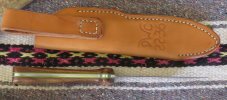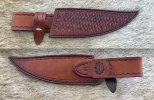PEU
Gaucho Knifemaker
- Joined
- Aug 6, 2006
- Messages
- 1,176
This time of the year, when Bladeshow is near, the rush to finish knives intensifies, and the knives need sheats. I don't have a sewing machine, so hand sewing it is.
My problem is that my fingers are sore not of pushing the needle into the hole, but from taking it out. I guess there is some finger aid for doing this, but besides thimbles I found no references, and the thimble only helps with the inserting, not the pulling out of the needle.
Thanks in advance!
Pablo


My problem is that my fingers are sore not of pushing the needle into the hole, but from taking it out. I guess there is some finger aid for doing this, but besides thimbles I found no references, and the thimble only helps with the inserting, not the pulling out of the needle.
Thanks in advance!
Pablo














